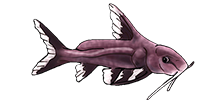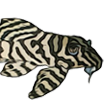Article © Robert Budrovcan, uploaded July 23, 2013.
Translation by Ingo Seidel
Part 1 of "The L236 Story" is a catfish of the month article.
Everybody who attempts to breed fishes (in my case callichthyids and l-plecos) starts with species that are easy to breed. When you have success with these then, after a while, one normally searches for new or rare species. The problem is that it is often difficult to obtain the most desired species in the pet trade and I had this problem many times. As a breeder, I exclusively breed for the wholesaler Aquarium Glaser in Rodgau, Germany. During a visit in June 2002 found two single specimens of Hypancistrus sp. L 236. What luck, I initially thought. But when I looked on the price tag, I was not happy anymore. They were a horrible price but the colour pattern was so very similar to the well known photo of the fish taken by Andreas Hartl and published in DATZ magazine. Because of the high price I was not able to pay for the fishes out of my fish credit; so I had to reserve them and talk with my wife about them. But I wanted to have these fishes anyway. We found a solution and two weeks later I was the proud owner of two specimens of L236 of 8-9 cm length, but the sexes were not visible at that time. I have bred many other Hypancistrus species, so was experienced with this genus. As I am not a beginner, I saw a good chance that I would be able to breed them.
/17.jpg) The pinnacle is snow white specimens with a high contrast approx. 10 cm female (Photo: Ingo Seidel) |
/18.jpg) This beautiful approx. 10 cm long specimen bred by the author shows a yellowish ground colour (Photo: Ingo Seidel) |
/19.jpg) Fundamentally, adult males seem not to be as colourful as females (Photo: Andreas Tanke) |
/20.jpg) Nice white L236, but it has a relatively rough colour pattern (Photo: Ingo Seidel) |
My installation consists of 40 glass tanks of different sizes and so I had a good choice of tanks to put them in. But I still had to think about what tank I should use. I decided to keep them in a tank of a size of 70x70x35cm. Because of its size, this tank had a stable water quality. It was filtered with a Hamburg Matten filter on the edge of the tank. Additionally an Eheim 2028 filter rated at 1050 litres per hour was running outside the tank and filtering it too. As Hypancistrus species like warm temperatures, I have an appropriate room climate and keep the temperature at 28 to 30 °C. I keep the fishes in tap water with a conductivity of 450 μs/cm and a hardness of 12 °dGH and 8 °KH. I change water once a week out of two water-butts of 500 litre size, that stand in the same room, so that the cold water gets room temperature. That´s important for not shocking the fishes with too cold water.
/21.jpg) Raising L Plecos Budrovcan style (Photo: Andreas Tanke) |
/22.jpg) Even during the raising of L236 we notice head deformities from time to time (Photo: Andreas Tanke) |
/23.jpg) Juveniles of L236 (Photo: Andreas Tanke) |
/24.jpg) Grow-out takes place alonside other l-numbers, but ensure they look very different so that you cannot confuse them. (Photo: Andreas Tanke) |
To provide a good environment I offered them a lot of breeding caves (closed at one end) which were stacked using pieces of slate. Two or three times a week I fed them frozen brineshrimp. Every day I gave them high quality granule food. Although they were doing very well under such a feeding regime, they were not inclined to reproduce. They were eating well however and had reached a size of 10-12 cm. Once a year I spend my summer holiday together with my family. This is a breeding break for the fishes in the summer months. The heaters are switched off during this time for several weeks so that the temperature sinks down to 24-27 °C. Naturally the fishes are on a „holiday diet“ during that time. My friendly neighbours keep an eye on the fishes, but they only feed a little bit of dried food from time to time. This then was the scene in August 2003. When I checked through my installation upon return from holiday, I noticed one of the L 236 sitting on a cluster of eggs. I couldn´t believe it, I had a pair!
The very big and yellow coloured eggs were fanned with fresh water by the male for six days. On the seventh day the fry hatched out of the eggs. I left them for a further five days in the males cave and then I transported them into a separate nursery tank. The number of eggs is comparable with Hypancistrus zebra and fluctuates between 8 and 15. One cluster of eggs consisted of 28 eggs. But this has been an exception. The raising of the fry is described in the third part in more detail by Ernst Schmidt, with whom I co-operate very closely.
/25.jpg) Juvenile's patterning can be rough in the beginning, but often improves (Photo: Andreas Tanke) |
/26.jpg) Two promising L236 juveniles (Photo: Ingo Seidel) |
A peculiarity of L236 I would like to mention here. I noticed that they are much more aggressive and territorial among each other than other Hypancistrus species. A male normally doesn´t accept any other L 236 nearer than 10-15 cm to the area surrounding of his cave. If you keep more than one male in a tank there is mostly one alpha male, that is breeding more often or alone.
The colour pattern of the fry was a little bit disappointing in the beginning. Many of the juveniles showed a narrow black and white pattern similar to L066. But my persistence was rewarded in the end. With every breeding success I could select out single specimens with a huge amount of white colour. So I had to do strong selection during the breeding. By doing this I could meanwhile (August 2011) increase the percentage of white coloured specimens in the offspring to 15-20 %. These juveniles even keep the nice colour into the age. But even the other specimens have the genetics to produce white juveniles, but in a lower percentage. So it is extremely exciting for me how the development will be for the future.
There is further information on this species on the Cat-eLog page.
Back to Shane's World index.




